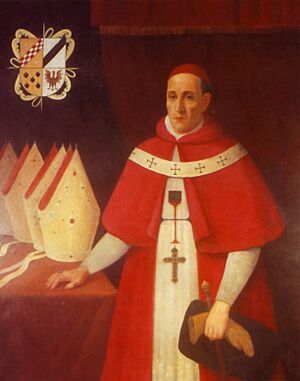Diego Morcillo Rubio de Auñón facts for kids
Fray Diego Morcillo Rubio de Auñón was an important Spanish leader. He was a bishop and served twice as the viceroy of Peru. A viceroy was like a governor chosen by the king to rule a colony. Diego Morcillo was born in Spain in 1642 and passed away in Lima, Peru, in 1730.
Contents
Life and Career of Diego Morcillo
Early Life and Studies
Diego Morcillo joined a religious group called the Trinitarian Order when he was young. He studied theology, which is the study of religious beliefs, at the University of Alcalá in Spain. King Charles II of Spain chose him to be a preacher for the royal family. He also worked as an examiner for the Supreme Council of the Inquisition. This council was a powerful religious court in Spain.
Becoming a Bishop
Diego Morcillo's church career grew steadily. In 1701, he became the bishop of Nicaragua. A bishop is a high-ranking church official. Later, he became the bishop of La Paz in Bolivia in 1708. In 1714, he was named the Archbishop of La Plata o Charcas. An archbishop is a bishop of a main or important diocese. Finally, in 1723, he became the Archbishop of Lima, which was a very important position in Peru.
First Time as Viceroy
In 1716, while he was the Archbishop of Charcas, King Philip V of Spain chose him for a new role. He was named the interim viceroy of Peru. "Interim" means he held the position temporarily. He took over the role on August 15, 1716. He served as viceroy until October 5, 1716. After that, a new permanent viceroy arrived, and Diego Morcillo went back to his duties as archbishop.
Second Time as Viceroy
Diego Morcillo became viceroy again on January 26, 1720. This time, it was a permanent appointment. He was now the main ruler of the colony for the king. When the Archbishop of Lima passed away, Diego Morcillo also took on that important church role. This meant he held two very powerful positions at the same time.
Achievements as Viceroy
During his time as viceroy, Diego Morcillo achieved several important things. He managed to greatly increase the money that went to the Spanish king from the colony. He also helped protect the coast of Peru from English pirates.
He was known for being smart and a good leader. He wrote a book called Clamores de la obligación. He also gave a lot of money to his religious order, the Trinitarian Order. He supported charities like hospitals and schools. He also helped build a convent for nuns in his hometown.
The Comuneros Revolt
In 1722, Viceroy Morcillo had to deal with a problem in Paraguay. It was called the Revolt of the Comuneros. The governor of Paraguay, named Reyes, had been removed from his position. A judge from a court had found Reyes guilty of wrongdoing. However, this judge was then given the power to become the new governor himself. This seemed unfair and created a conflict of interest.
Viceroy Morcillo believed that choosing a governor was not a judge's job. He said that the judge's decision was not valid. He insisted that Reyes should be put back in his position.
Retirement and Death
Being both an archbishop and a viceroy was a lot of work, especially since he was in his eighties. Because of this, Diego Morcillo decided to retire in 1724. He passed away in Lima in 1730. He was buried in the crypt of the main cathedral there.
See also
 In Spanish: Diego Morcillo Rubio de Auñón para niños
In Spanish: Diego Morcillo Rubio de Auñón para niños


